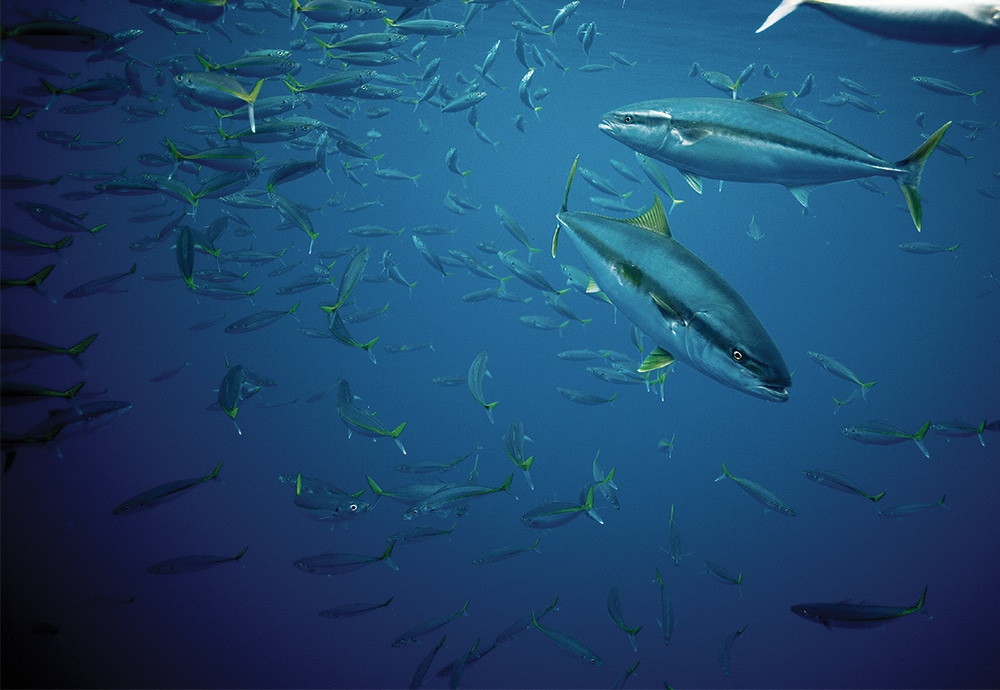
As someone who grew up fishing from sport boats off the Southern California coast, I’d spent the better part of 25 years perfecting my techniques for California yellowtail, and considered myself to be quite proficient at catching these beautiful, hard-fighting Pacific Ocean members of the jack family. That was until I bought my own boat and realized I’d been fooling myself all along. I didn’t know how to fish for yellowtail. I only knew how to catch them once someone else put me on a school of biting fish.
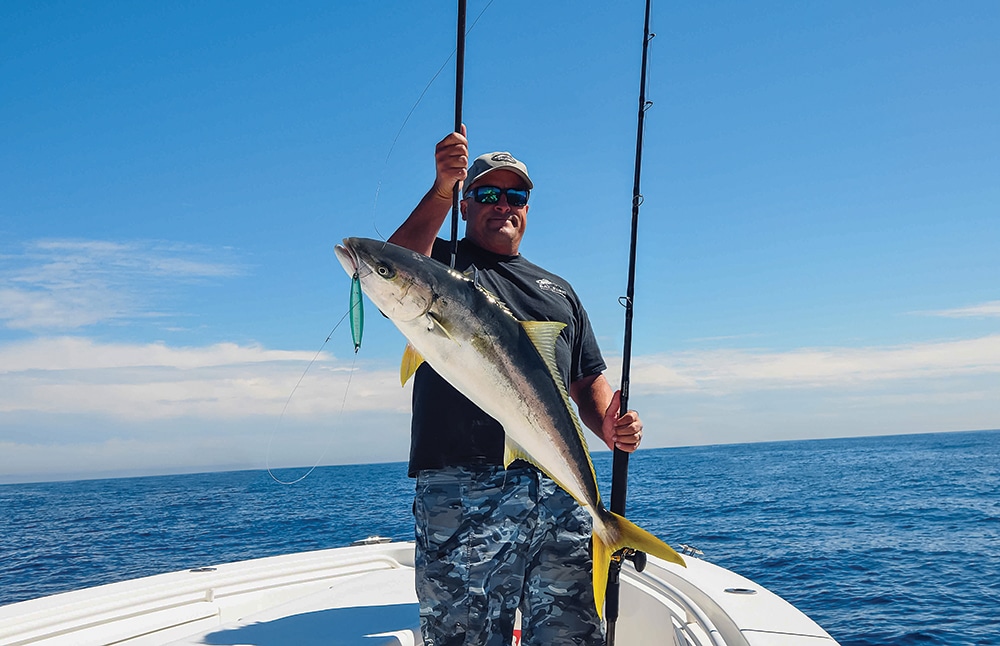
Like every angler who has ever stepped off a passenger sport-fishing boat and into a boat of his own, I was now tasked with figuring out all of the things that had previously been taken care of for me. That basically included all the steps that occurred between leaving the dock and setting the hook on a yellowtail. I won’t bore you with the tedious, and often frustrating, details of how I went about learning the ropes, but suffice it to say that after several years of trial and mostly error, I can now proudly call myself a decent yellowtail fisherman. But I wanted to take my skill to the next level, so I asked my friends, captains Duane Mellor and Greg Trompas, a couple of proven pros, to share their secrets for consistently finding and catching big yellowtail.
“We’re really not doing anything all that special, but we’re happy to show you our program,” Mellor assured me as we stowed our gear on Trompas’ 21 1⁄2-foot Cabo 216 center-console and headed toward the bait receiver in San Diego’s Mission Bay. This was immediately followed by him asking, “What’s so funny?” Rather than explain that I was laughing at myself and all the effort I’d put into unsuccessfully cracking the code of what he considered “not doing anything all that special,” I just shook my head and replied, “Nothing. I’m just excited to go fishing.”
Designing a Yellowtail Fishing Game Plan
While we focused our efforts on the waters below San Diego, the same strategy will work virtually anywhere in Southern California, be it Santa Monica Bay, Santa Catalina Island, Dana Point or elsewhere.
The first step in any successful fishing trip is coming up with a game plan for the day. Since our goal on this trip was to cover as many yellowtail-fishing scenarios as possible, Mellor and Trompas strategized on how best to break up the day. “It’s important to consider all of the information you have available when deciding where and when to fish,” explained Trompas.
“It helps to know the general area where the fish have been biting, but that will get you only so far. To come up with a good plan, you’re going to need to know when and why the fish are biting in that area. It might be a time-of-day bite, it could be tide dependent, or the fish might be in a particular area because that area is holding bait schools. Sometimes you can get that information from friends who’ve been on the fish, but other times you’re going to need to make an educated guess as to what the fish are doing based on your experience with fishing those areas.”
“To come up with a good plan, you’re going to need to know when and why the fish are biting in that area.”
— Greg Trompas
For this summer trip, the plan started out with a visit to the bait receiver to load up on Pacific sardines. Once baited up, we’d cruise along the Point Loma Peninsula before heading south to Imperial Beach, just above the United States/Mexico border.
We would also cruise farther south, venturing into Mexican waters to a high spot known as the Rockpile, and finally back up to Islas Los Coronados — a group of small, rocky Mexican islands about 14 miles from Point Loma. Glad that I’d packed a big lunch, I sat back and prepared myself for a very long day on the water. (As a reminder to anglers, you need both a Mexican fishing license and an FMM visa to fish in these Mexican waters now.)
Looking for Signs of Yellowtail
Once clear of the harbor, I sensed an abrupt change in the mood on the boat. Both Mellor and Trompas, who moments before had been sitting down drinking coffee and telling stories, suddenly became all business. Now on their feet, Mellor’s gaze was fixed on the horizon, while Trompas’ head was on a swivel between the fish finder and the kelp beds we passed. “We’ve caught fish along this entire stretch over the years,” said Mellor, while waving his arm to encompass the entire Point Loma Peninsula. “So there’s no reason they can’t pop up anywhere along here.”
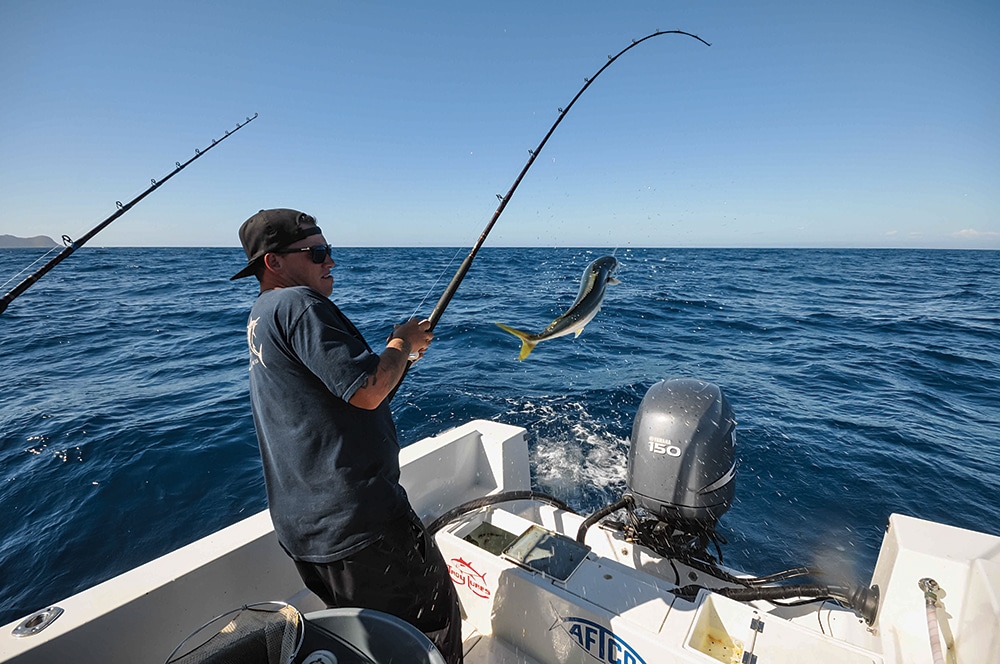
I asked what he was looking for; Mellor replied: “Birds. They’re the best indicator of feeding activity, but just because there are birds flying around or sitting on the water doesn’t mean the yellows are biting. If you can find white terns that are hovering in place or dipping in the water, nine times out of 10, if there are biting fish in the area, they are going to be under those birds. Sometimes there will be some seagulls and pelicans mixed in with them if it’s a big spot of fish, but if it’s just seagulls or pelicans without any terns, there probably won’t be any yellowtail there.”
Not finding birds, or any other signs of life for that matter, we made our way down to the sand flats off Imperial Beach. “I got in on a good morning bite on the yellows down here earlier this week, but conditions look a lot different today,” said a disappointed Trompas shortly after pulling the boat off-plane. “There were bait schools all over the hard bottom around the [Imperial Beach sewer] pipe, and there were big yellows on them, and they were biting pretty well.” With no bait on the fish finder, and the water looking dirtier than in previous days, Trompas pronounced the area dead and decided to run to the Rockpile.
How to Find Deepwater Yellowtails
While making our way into Mexican waters, Trompas had time to fill me in on the finer points of targeting deep-water yellowtail. “The yellows we’ve been catching down here have been coming off deepwater bait schools around high spots on the [Rockpile] bank. So what we’ll be doing is driving around looking for bait schools [on the fish finder] with yellows marking around them.”
According to Trompas, some variation of what works at the Rockpile will work wherever you find yellowtail in deep water. “It doesn’t matter if you’re fishing along the Baja coast or at one of the Channel Islands out of Ventura, yellows feeding on deep bait schools basically all mark the same. So once you find the fish, it’s just a matter of fine-tuning your presentation to get them to bite.”
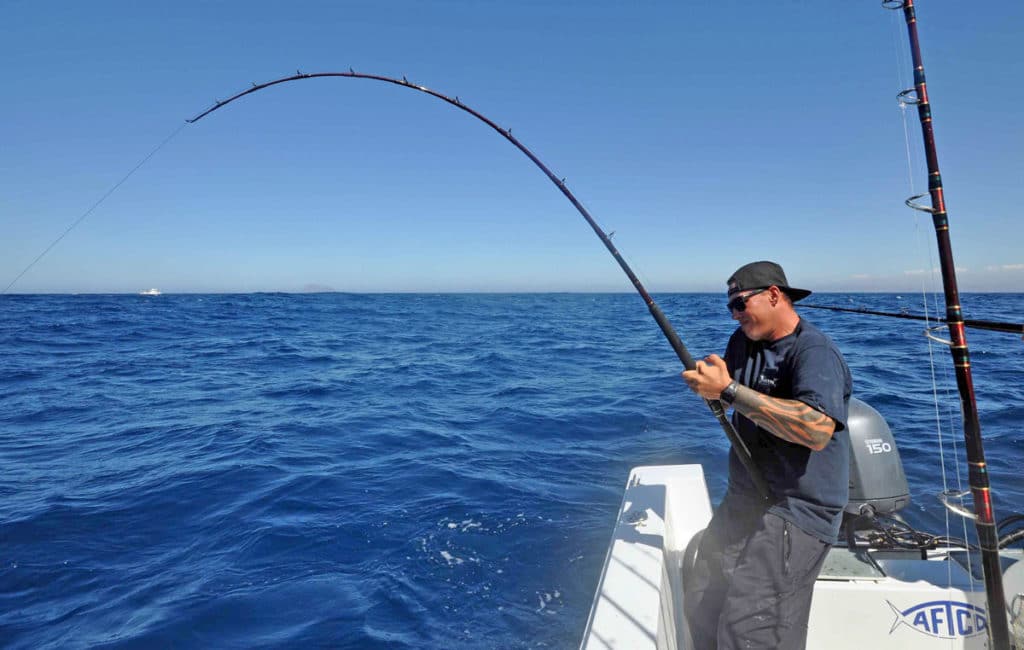
Upon our arrival, the Rockpile looked devoid of life, but Trompas seemed very confident. “All of the yellows down here have been deep, so I’m not too concerned about not finding birds,” he explained. Moments later we marked our first school on the fish finder. Trompas pulled the boat out of gear, and Mellor threw a couple of netfuls of sardines as chum to help attract the yellows closer to the surface, before both grabbed their rods and dropped heavy metal jigs to the bottom in 150 feet of water. “You’ve got to get down fast when you get a mark,” said Trompas, while winding a Salas 6X heavy jig as fast as he could turn the reel handle — a technique known as yo-yo fishing. “These fish aren’t sitting still — they’re chasing bait schools — so you want to get on them before they swim out from under the boat.”
Our first few spots produced Pacific bonito, hard fighters, but less desirable than yellows. Yet as high tide approached, we started to get the right bites. “The tides will almost always have an effect on the fishing, but it varies as to which part of the tide the fish will bite best.” Trompas elaborated. “I’ve had days where I’d mark fish for hours without getting a bite. Then, like someone threw a light switch, I’d get bit on every bait. My advice is to pay attention to what the tide was doing when you got bit and try to look for a pattern in that area on future trips.”
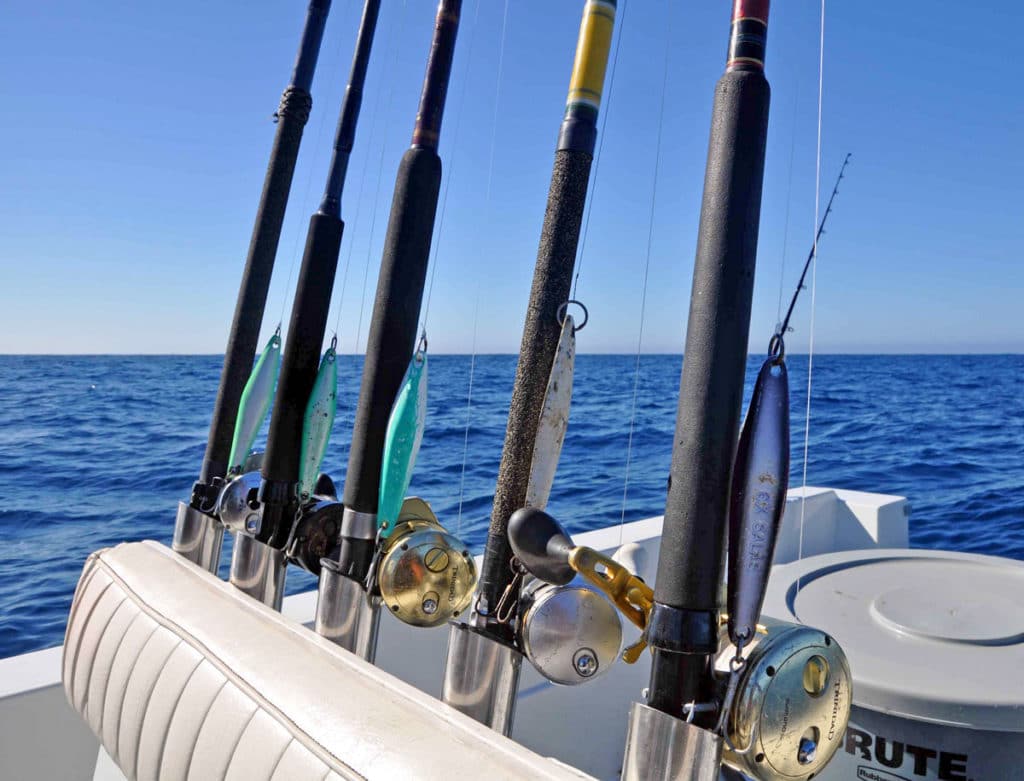
Speaking of biting fish, Mellor and Trompas were really starting to get dialed in. After a few hit-and-miss spots, they refined their strategy and were now catching fish on almost every stop. As Trompas pulled on yet another yo-yo yellow, Mellor explained what was happening. “When we first got here, we were stopping on just about any mark we’d get. But after we’d caught a few fish, we noticed that the biting fish marked differently than the ones that didn’t, so now we’re stopping only on marks that look like biting fish.” (Reference “Seeing Yellowtail on a Fish Finder,” below.)
Action at the Rockpile continued for most of the morning, and by midday we’d caught at least 20 yellows using the yo-yo technique. Many of the smaller fish were released, but we’d managed to put a half-dozen better-grade fish in the kill bag before running up to the Coronados in search of bigger targets. A strong west wind made the 7-mile passage seem a lot longer because we were forced to slowly pound our way uphill toward the lee of the southernmost and largest of the isles: South Island.
Locating Yellowtail Fishing Spots
As we approached the islands, Mellor took charge because these were his stomping grounds. “The islands fish a lot differently than the Rockpile. This morning we were driving around a big area looking for fish that were following bait schools, but now we’re going to drive around looking for small spots that are holding fish. All of the islands along the Southern California coast have a bunch of high spots, ridges and hard-bottom areas scattered around them. So I’ll focus on looking for small spots that have the right conditions to go along with some signal of feeding activity.”
After running toward a false alarm that ended up being birds following a sea lion eating a bonito, Mellor found an area that looked good. Running slowly along a ridge in 70 feet of water, Mellor kept a slow chum line of live sardines going until he reached the upwind edge of the ridge. “This whole ridge is marking with scattered fish, so let’s make a drift through here,” he announced.
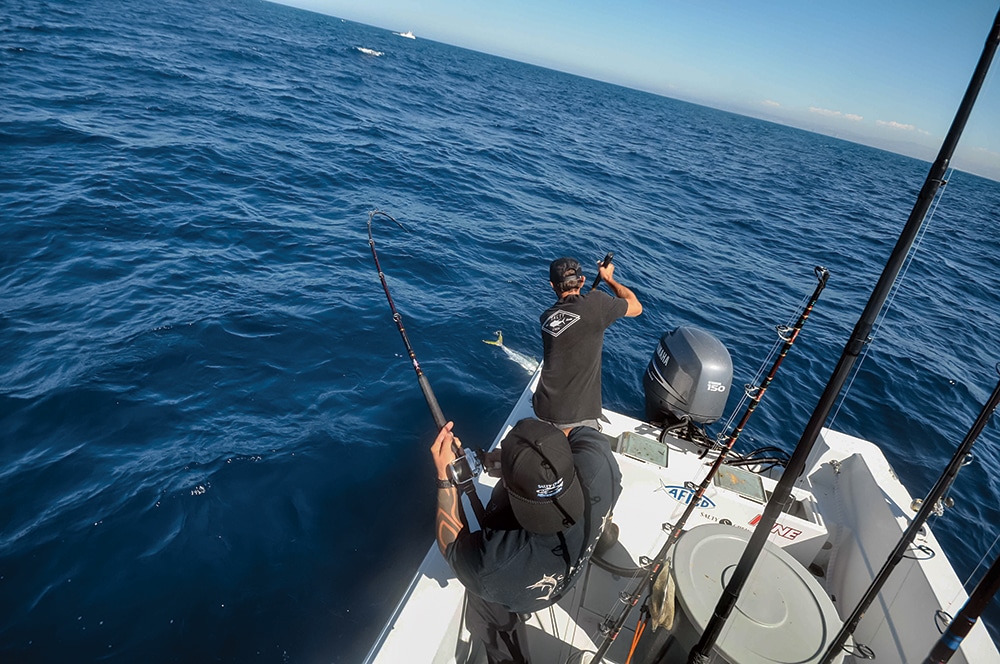
This time we tried a different kind of metal jig known as surface iron. These are made from a lighter alloy and designed to swim seductively from side to side when retrieved properly. I made a long cast in the general vicinity of a tern that was hovering over the water, and within a couple of cranks, my jig was annihilated by a healthy yellowtail. As I fought my fish, both Mellor and Trompas cast into the same zone and instantly hooked fish. This continued for the rest of the drift, and each of us managed several more surface-iron yellows within the next half-hour.
“That’s pretty much island fishing in a nutshell,” explained Mellor as we went in search of our next spot. “The fish are almost always exactly where they should be. If you find good water color and clarity, stable temperatures, bait and birds, you’ll usually find biting fish. A lot of guys get freaked out because they don’t know where the ridges and high spots are, but that’s easy to learn. If you’re fishing an unfamiliar area, just drive around watching your fish finder, and mark any spots you run over [as waypoints on your GPS]. While you’re doing that, you can slow-troll a couple of sardines to help you locate biting fish.”
With the sun riding low on the horizon and the afternoon winds having finally blown themselves out, we cruised back to the harbor with plenty of yellowtail in the kill bag. “I told you we weren’t doing anything all that special,” said Mellor. “We just pay attention to what the fish are doing and what the conditions are telling us. Then we take that information and match it up with our past experiences to look for patterns that might result in putting fish in the boat.”
He was right. It really didn’t sound all that special, but having the ability to sum up an entire fishing strategy in such simple terms is something very special indeed.
Yellowtail Jig-Fishing Basics
California yellowtail often prefer metal jigs to live bait, but choosing the right jig for the situation is key. When fishing schools in deep water, drop a heavy jig such as a Tady 4/0 or Salas 6X Jr all the way to the bottom, and wind it as fast as you can, while occasionally pausing the retrieve. This is called yo-yo fishing. To properly fish the jig, you’ll need a 7-foot heavy-action rod matched with a high-speed reel filled with at least 40-pound-test. A Calstar Graphiter 700H or similar rod matched with a reel such as a Penn Torque 30 full of 80-pound Spectra with a 3- or 4-foot leader of 60-pound fluorocarbon will give you plenty of pulling power to get a big yellowtail coming up and away from the rocky bottom.
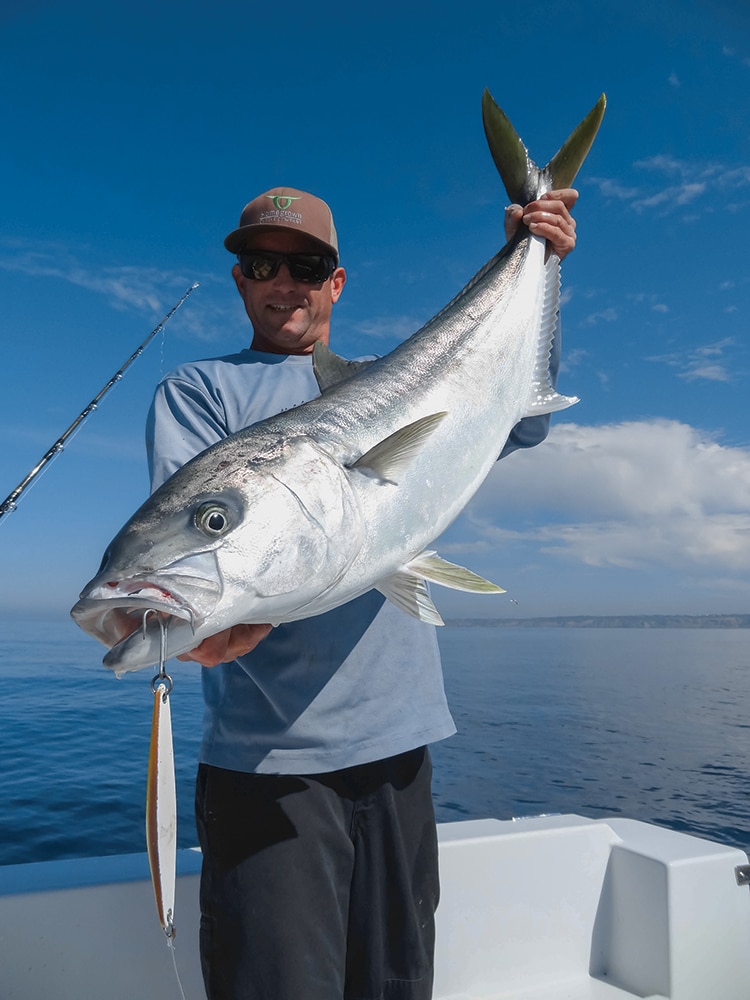
When the fish are high in the water column, try a lighter metal jig such as a Tady 45 or Salas 7X. These swimming lures, known as surface iron, can be deadly. Keep an eye out for any birds that are looking hard at the water or yellows that are boiling on forage fish, then let your surface iron fly. Once you’ve made an accurate cast to the area where you saw the fish, retrieve the jig with a medium to fast wind and hang on. Long rods rule for fishing surface iron, and most anglers use 9- or 10-foot rods to give them casting distance. The drawback to these longer rods is that they sacrifice leverage. I prefer an 8-foot rod for that very reason, and have had great success fishing a model such as a Cousins CJB 80M-CT matched with a Penn Fathom 25N loaded with 65-pound Spectra and a short 60-pound fluorocarbon leader. Whether yo-yoing heavy iron or swimming a surface iron, once a fish strikes, just keep reeling until the fish is pulling line. Trying to set the hook will usually just pull the lure out of the fish’s mouth.
Seeing Yellowtail on a Fish Finder
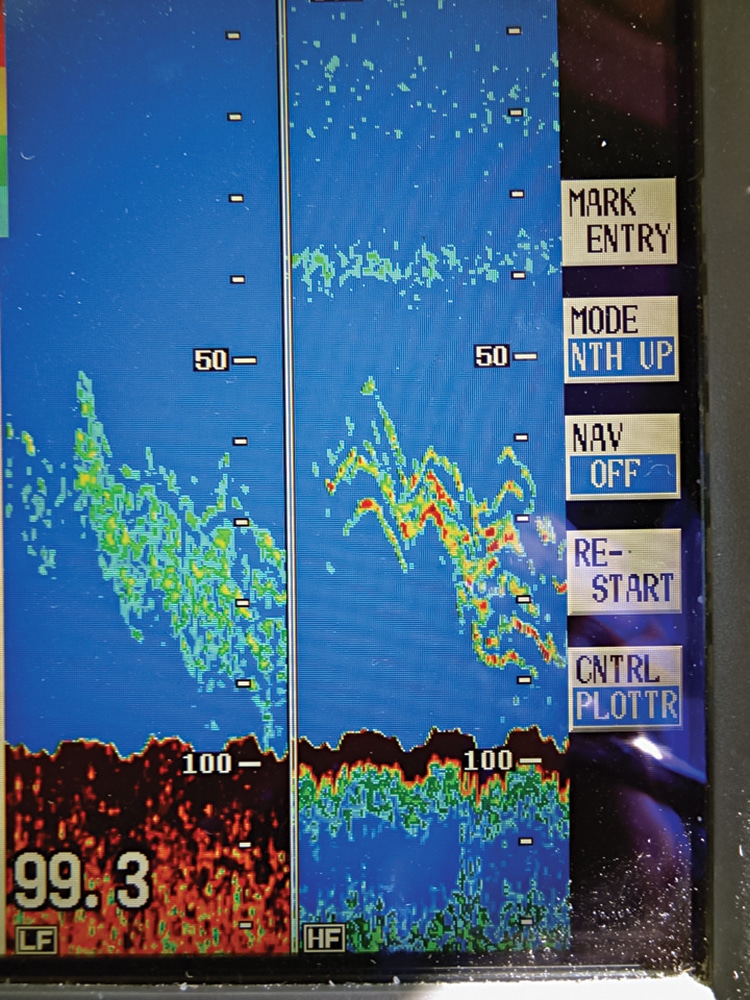
Trying to figure out what a school of yellowtail is doing 60 feet under your boat might seem like an impossible task, but if you pay attention to what your fish finder is telling you, it’s actually simple. Yellowtail are schooling fish, and the school tends to mark differently depending on what they are doing. If you run over a school of yellows that’s on the move, you might mark only a small chunk of the school in the moment that the school intersects with the beam of your sonar. On the flip side, inactive fish will often mark as long worms as they cruise slowly under the boat, allowing time for your fish finder to ping off the same fish multiple times. Biting schools, however, will show up as scattered marks that are moving diagonally up or down on the finder as they fan out to chase down baitfish.
Run-and-Gun for Summer Yellowtail
During summer, chasing bird schools is a popular way to target California yellowtail, but it can lead to frustration when too many boaters are fishing the same school. Mellor suggests driving away from the fleet to find a school that hasn’t been trampled by other boaters because the fish will be more likely to bite. Also, never drive up to the school from behind. The proper technique is to run parallel a good distance away from the school until you are ahead of them, and then turn into the path of the school, pull the boat out of gear, and wait for the fish to swim within casting range.
ABOUT THE CAPTAINS
Capt. Duane Mellor runs the four-pack charter boat Seasons Sportfishing out of Dana Landing in San Diego. This 25-foot Parker pilothouse offers comfortable accommodations and is fully equipped for everything from half-day local to full-day offshore fishing trips.
Capt. Greg Trompas specializes in targeting big yellowtail, white seabass and tuna from his 21 1⁄2-foot Cabo 216 center-console. Best suited for groups of three or fewer, he’s a great choice for die-hard fishermen who are looking to catch the fish of a lifetime.
ABOUT THE AUTHOR
Erik Landesfeind is an inshore-fishing specialist who lives in Long Beach, California. He splits his time between fishing saltwater-bass tournaments and targeting pelagic species in his 18-foot bay boat. He has more than 30 years’ experience in fishing the waters off Southern California and Mexico.








